INDIAN ARMED FORCES CHIEFS ON OUR RELENTLESS AND FOCUSED PUBLISHING EFFORTS

The insightful articles, inspiring narrations and analytical perspectives presented by the Editorial Team, establish an alluring connect with the reader. My compliments and best wishes to SP Guide Publications.

"Over the past 60 years, the growth of SP Guide Publications has mirrored the rising stature of Indian Navy. Its well-researched and informative magazines on Defence and Aerospace sector have served to shape an educated opinion of our military personnel, policy makers and the public alike. I wish SP's Publication team continued success, fair winds and following seas in all future endeavour!"

Since, its inception in 1964, SP Guide Publications has consistently demonstrated commitment to high-quality journalism in the aerospace and defence sectors, earning a well-deserved reputation as Asia's largest media house in this domain. I wish SP Guide Publications continued success in its pursuit of excellence.
Pakistan Orbiting Back into Space Exploration
In a first, Pakistan’s satellite, iCUBE-Q, was launched on May 3, 2024 to orbit the moon as part of China’s Chang’e-6 lunar mission

In a first for the country, Pakistan’s satellite, iCUBE-Q, was launched on May 3, 2024 to orbit the moon as part of China’s Chang’e-6 lunar mission. Led by the China National Space Administration (CNSA), the mission targets the South Pole-Aitken Basin to gather dust and rock samples, providing invaluable insights into the composition and characteristics of this lunar region. Weighing about 7 kg, Pakistan’s maiden lunar satellite iCUBE-Q was developed through collaboration between Pakistan’s Institute of Space Technology (IST) and China’s Shanghai University.
CUBE-QAMAR
Riding aboard the Chang’e-6 probe, the iCUBE-Qamar was deployed from the Chang’e-6 spacecraft on May 8. The iCUBE-Q orbiter carried two optical cameras to image the lunar surface. Alongside capturing images, the iCUBEQ orbiter is also collecting valuable data on the lunar magnetic field and laying the groundwork for future missions and international collaborations. The data collected by this miniature satellite will provide valuable insights into the Moon’s topography, geological features, and potential resource deposits.
The module is a cube satellite or CubeSat. CubeSats, categorised as nanosatellites, follow standardised size and form factors, typically beginning with a “one unit” or “1U” size measuring 10x10x10 cm but extending to larger sizes like 1.5U, 2U, 3U, 6U, and 12U. Their development has burgeoned into a thriving industry, with collaboration among government, industry, and academia aimed at enhancing their capabilities. CubeSats provide a cost-effective platform for various purposes, including scientific research, technology demonstrations, and innovative mission concepts like constellations and swarms. These miniature satellites, primarily cubic in shape, consist of modular components that adhere to specific size constraints and weigh only a few kilograms, primarily serving scientific research and educational initiatives in space exploration. iCUBE-Q is aimed to support scientific research, technological advancement, and educational endeavors within the realm of space exploration for Pakistan.
The Chang’e-6 rocket took five days to reach the moon’s orbit, deploying iCUBE-Qamar on May 8 into a meticulously chosen 12-hour elliptical orbit
China’s Chang’e-6 mission aims to explore the far side of the Moon and collect up to 2,000 grams of lunar material for analysis upon its return to Earth. As part of the mission, the Chang’e-6 lunar probe carries payloads from various international partners, including the European Space Agency (ESA), France, and Pakistan, showcasing collaborative efforts in space exploration. This mission also follows China’s successful return of samples from the Moon’s near side in 2020.
CAPTURING THE MOON & SPACE EXPLORATION
iCUBE-Q, transmitted its initial images from orbit after completing three lunar orbits successfully. Released by the Space and Upper Atmosphere Research Commission (SUPARCO), Pakistan’s Space Agency, the data was transmitted by the CubeSat and delivered to Pakistan by China. The Chang’e-6 rocket took five days to reach the moon’s orbit, deploying iCUBE-Qamar on May 8 into a meticulously chosen 12-hour elliptical orbit, enabling imaging of targeted lunar surfaces. Pakistan’s CubeSat project achieved the set goal of successfully separating and obtaining telemetry’ and achieved complete success, the CNSA announcement said.

The images, captured between May 8 and 9, offer a glimpse of the lunar surface, showcasing the details of its rugged terrain and craters. The first image showed the sun as a bright spotlight; the second was that of a sparkling half moon while the third image showed the moon on the left and the sun on the right. One particularly striking image depicts the Earth’s natural satellite alongside the Sun. The images were unveiled at a ceremony organised at CNSA to mark the successful mission, and were then officially handed over to Pakistan’s ambassador to China.
Pakistan’s space agency, SUPARCO, founded in 1961, has faced challenges including funding constraints and misplaced priorities, resulting in limited progress especially compared to India’s ISRO (Indian Space Research Organisation) that started in 1969.”
In 2022, CNSA offered an exclusive opportunity to member states of the Asia Pacific Space Cooperation Organisation (APSCO) to include a studentdesigned payload on the Chang’e 6 mission to the moon. Pakistan’s iCUBE-Q was selected through that.
PAKISTAN’S SPACE SOJOURN
Pakistan’s foray into lunar exploration marks a significant step forward for the nation’s space programme. China’s burgeoning space exploration programme underscores its emergence as a formidable competitor in the global space race. Concurrently, Pakistan is also restarting to make strides in space exploration with iCUBE-Q its inaugural lunar mission. This mission follows closely on the heels of India’s Chandrayaan-3 soft-landing on the moon’s south pole about nine months back.
Pakistan’s space agency, SUPARCO, founded in 1961, has faced challenges including funding constraints and misplaced priorities, resulting in limited progress especially compared to India’s ISRO (Indian Space Research Organisation) that started in 1969. Pakistan’s inaugural National Space Policy coming out at the end of 2023, marked a pivotal moment in its scientific journey, aligning with global trends in space privatisation amidst geopolitical complexities. Despite historical challenges, including economic constraints and political instability, Pakistan aims to leverage its new policy to overcome obstacles.

Pakistan’s space aspirations are embodied in its Space Programme 2040, later renamed Space Vision 2047, launched in 2011. Embracing private sector involvement and emphasising international collaboration, Pakistan seeks to position itself as an emerging space economy. To further advance its space programme, Pakistan must prioritise public-private collaborations, establish global partnerships, invest in STEM education, and develop a supportive legislative framework. Initially partnering with NASA (National Aeronautics and Space Administration) at the beginning of its space programme, Pakistan eventually shifted its focus to China leading to stronger bilateral collaboration. Despite challenges like budget cuts and a lack of expertise, recent efforts bring some hope to revitalise Pakistan’s space programme.
PAK-CHINA SPACE COOPERATION
As China and Pakistan journeyed towards the moon, the iCUBE-Q mission also emphasised strengthening lunar exploration collaboration between the two nations. However, this collaboration is not new. Beginning its space journey with the establishment of SUPARCO in 1961, Pakistan collaborated with NASA to launch its first communication satellite, Rehbar-1, in June 1962. Bilateral collaboration between Pakistan and China commenced in 1991 and has since strengthened, with proposals to integrate space cooperation into the China-Pakistan Economic Corridor (CPEC) through a “silk space road.” In 1990, Pakistan launched the Badr-1 satellite from China’s Xichang Satellite Launch Center using a Long March 2E rocket.
The data collected by this miniature satellite will provide valuable insights into the Moon’s topography, geological features, and potential resource deposits
In space, Sino-Pakistani cooperation also extends to Intelligence, Surveillance, and Reconnaissance (ISR) and satellite navigation services. Since 2013, Pakistan has been integrated into China’s BeiDou Satellite Navigation system. Pakistan operates satellites like the Pakistan Remote Sensing Satellite-1 (PRSS-1), launched by China in 2018, and the PakTES-1A, developed by SUPARCO and in 2020, China agreed to establish a BeiDou-linked CORS in Pakistan. This collaboration enhances Pakistan’s missile forces’ accuracy and penetrability. China’s provision of the SLC-18 radar system, capable of detecting satellites and ballistic missiles, underscores the deep alliance between the two countries. Collaboration between CNSA and SUPARCO on a human spaceflight framework has also been indicated. In 2023, Pakistan also joined China’s International Lunar Research Station.
In an era marked by renewed interest and fervent competition in space exploration, both nations are poised to contribute groundbreaking discoveries. As Pakistan sort of restarts its space journey, it is not only a display of its pursuit of scientific advancement in this subject but will also be critical in defining the dynamics of the already volatile geopolitical conditions, economic fluctuations and the growing space activities.
EXPERT’S VIEWS: CHINA-PAKISTAN SPACE COOPERATION
China has a very advanced space programme. Pakistan’s Space & Upper Atmosphere Research Commission (SUPARCO) was established in 1961. The agency had little to show in the initial 30–35 years. The country’s first technology-demonstrator satellite, Badr-I, was built by SUPARCO, and launched by China in 1990. SUPARCO played a significant role in the development of Pakistan missiles such as Hatf-I and Hatf-II that was supported by China based on its M-11 missile. Pakistan does not have its own launch vehicles and aims to launch more satellites with Chinese help. Since 1992, China has helped Pakistan develop and launch communications satellites and remote sensing satellites, among others.
Pakistan Remote Sensing Satellite (PRSS) programme was planned to be a progressive and sustainable programme with an initial plans to launch an optical satellite with payload of 2.5 metre PAN in 700 km Sun-synchronous orbit by the end of year 2014, which was to be followed by a series of optical and SAR satellites in future. The programme finally got going in 2018, when China launched two remote sensing satellites for Pakistan, which were to monitor progress of the China–Pakistan Economic Corridor. The satellites were named PRSS-1 and PakTES-1A. The PRSS-1 is China’s first optical remote sensing satellite sold to Pakistan. The PakTES-1A is an experimental satellite developed by SUPARCO.
The two nations signed a series of space exploration agreements in 2019 as part of China’s Belt and Road Initiative. They include China helping to train Pakistani astronauts and send them into space, and to the newly completed Tiangong space station in low-Earth orbit. Pakistan has access to the Chinese BeiDou satellite navigation system. iCUBE-Q, a scientific experimental Pakistani CubeSat was launched aboard China’s Chang’e-6 lunar probe on May 3 and has beamed first images. It is also the first satellite collaboration mission between Pakistan and China as well as the universities. A symbol of mutual trust, and youngsters’ exploration of the moon. The debt-ridden Pakistan has very little to invest in space programme currently and will remain dependent on China for years ahead.
—Air Marshal Anil Chopra (Retd),
former Director-General, Centre for Air Power Studies





